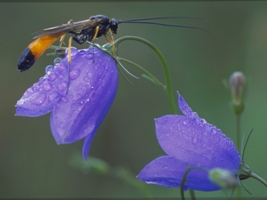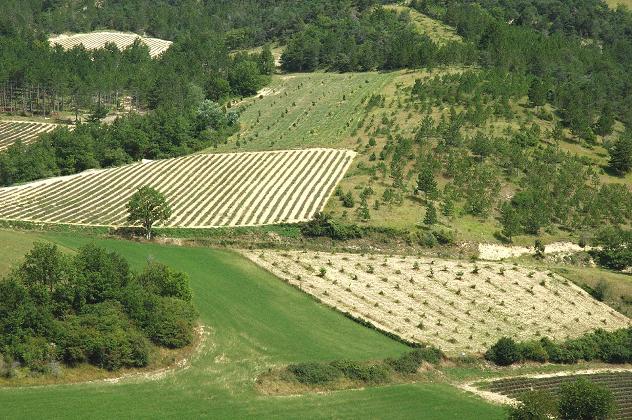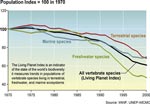
What is GLOBIO?
GLOBIO is a modelling framework to calculate the impact of five environmental drivers on land biodiversity for past, present and future.

Land use, here forestry, is one of the environmental drivers impacting biodiversity.
GLOBIO is based on cause-effect relationships, derived from the literature. To use GLOBIO no detailed species data are needed. Instead, the model uses spatial information on environmental drivers as input. This input is mainly derived from the Integrated Model to Assess the Global Environment (IMAGE).
The current version of GLOBIO, GLOBIO3, focuses on the terrestrial part of the globe. A module for the freshwater aquatic environment is under development (GLOBIO-aquatic). The Sea Around Us Project of the University of British Colombia (UBC) has developed a similar model for marine ecosystems: EcoOcean.
The information under this menu item refers to the current version of the model: GLOBIO3.
Read more...
Biodiversity, Food Forests, Food Plants - Annual, Food Plants - Perennial, Plant Systems
by Dr. Mae-Wan Ho September 23, 2008
Sustainable farming across the world relies on cultivating a diversity of crops and livestock to maximise internal input, and this is in marked contrast to the high external input monoculture of industrial farming, which is proving unsustainable in many respects. Indirect support for the sustainability of agricultural diversity is coming from an unexpected quarter. Academic ecologists are discovering that biodiverse systems are more productive.
by Dr. Mae-Wan Ho: Geneticist, Biophysicist and Director of the not-for-profit Institute of Science in Society.
 For over three decades, academic ecologists have debated whether complex, species-rich ecosystems are more stable than ones with fewer species. Unfortunately, there are many definitions of complexity, and even more of stability; and so the debate continues. For over three decades, academic ecologists have debated whether complex, species-rich ecosystems are more stable than ones with fewer species. Unfortunately, there are many definitions of complexity, and even more of stability; and so the debate continues.
The question most relevant to agriculture, and also most easily answered, is whether biodiverse systems are more productive. There is growing evidence that biodiverse systems are indeed more productive, although ecologists still disagree as to how that could be explained, and on the number of species needed to sustain an ecosystem, which has large implications also for conservation.
One hypothesis is that there is “niche complementarity” among particular combinations of species, in other words, they have mutually complementary relationships so the more species there are, the greater the chance occurrence of such complementarity. This would be due to both differences in resource requirements over space and time, and positive, symbiotic interactions between the species.
 Alternatively, the greater productivity associated with diversity may be due to short-lived or transient effects, caused solely by the presence of some species with high growth rate. Or the effects could simply be experimental artefacts. The species compared may happen to include some with very low-viability, or else with very high, competitive growth rates. These ‘sampling effects’ result from the greater chance of such species being present at higher diversity, and from dynamics that cause a single species to dominate and determine how the ecosystem evolves. Alternatively, the greater productivity associated with diversity may be due to short-lived or transient effects, caused solely by the presence of some species with high growth rate. Or the effects could simply be experimental artefacts. The species compared may happen to include some with very low-viability, or else with very high, competitive growth rates. These ‘sampling effects’ result from the greater chance of such species being present at higher diversity, and from dynamics that cause a single species to dominate and determine how the ecosystem evolves.
Fortunately, David Tilman and his colleagues in the University of Minnesota, St. Paul, and University of Nebraska, Lincoln, can now address these questions from the results of an experiment they started in May, 1994 and continued to this day [1].
Read more...
What is biodiversity?
- Biodiversity is the variability among living organisms from all sources, including terrestrial, marine, and other aquatic ecosystems and the ecological complexes of which they are part; this includes diversity within species, between species, and of ecosystems.
- Biodiversity forms the foundation of the vast array of ecosystem services that critically contribute to human well-being.
- Biodiversity is important in human-managed as well as natural ecosystems.
- Decisions humans make that influence biodiversity affect the well-being of themselves and others.
Biodiversity is the foundation of ecosystem services to which human well-being is intimately linked. No feature of Earth is more complex, dynamic, and varied than the layer of living organisms that occupy its surfaces and its seas, and no feature is experiencing more dramatic change at the hands of humans than this extraordinary, singularly unique feature of Earth. This layer of living organisms—the biosphere—through the collective metabolic activities of its innumerable plants, animals, and microbes physically and chemically unites the atmosphere, geosphere, and hydrosphere into one environmental system within which millions of species, including humans, have thrived. Breathable air, potable water, fertile soils, productive lands, bountiful seas, the equitable climate of Earth’s recent history, and other ecosystem services (see Box 1.1 and Key Question 2) are manifestations of the workings of life. It follows that large-scale human influences over this biota have tremendous impacts on human well-being. It also follows that the nature of these impacts, good or bad, is within the power of humans to influence (CF2).
Read more...
ELN-FAB
 The first conference ‘Towards a European Learning Network on Functional Agrobiodiversity’, held in The Hague, the Netherlands on 23 and 24 June 2008, resulted in the decision to establish a European Learning Network on Functional AgroBiodiversity (ELN-FAB). ECNC in cooperation with DIVERSITAS agroBIODIVERSITY International Project Office (AB-IPO) took up the coordination of this network, and the Netherlands Ministry of Housing, Spatial Planning and the Environment provided funding. The first phase of the project started in January 2009 and will run until the end of 2009. Further support and financial participation is being sought in order to expand the Network in the longer term. VisionBy 2030 the use of agrobiodiversity to enhance ecosystem services in a way that promotes sustainable agricultural production and contributes to sustainable rural development (triple P) is fully integrated into European agricultural policies and practices. MissionThe European Learning Network on Functional Agrobiodiversity is founded to exchange knowledge and practical experience across country and language borders, between farmers and policy makers, scientists, businesses and NGOs, to enable fast and effective implementation of best practices. This will help to optimize agrobiodiversity benefits, promote sustainable agriculture and will encourage widespread uptake of biodiversity concepts, thereby also enhancing non-agronomic ecosystem services. Objectives
The specific objectives of the project are to:
- stimulate dialogue, influence policy making and support implementation of best practices;
- generate and exchange knowledge on best and worst practices as well as on mechanisms and practices underlying functional agrobiodiversity;
- undertake outreach activities;
- provide advice to farmers, policy makers and scientists and other stakeholders.
Read more...
Background
 Biodiversity is the basis for agricultural production. On the one hand it is the origin of all crops and domestic livestock and the variety within them. On the other hand, components of wild biodiversity in agricultural and associated landscapes provide and maintain ecosystem services that are essential to agricultural production (e.g. pollination). Biodiversity is the basis for agricultural production. On the one hand it is the origin of all crops and domestic livestock and the variety within them. On the other hand, components of wild biodiversity in agricultural and associated landscapes provide and maintain ecosystem services that are essential to agricultural production (e.g. pollination).
Since nearly half of the EU’s land territory is farmed, this form of land use is in no doubt the main component of much of the semi-natural environment and the multifunctional landscapes within the European Union. Farming and biodiversity are interdependent and this is increasingly recognized by European policy makers. It is recognized that much of the negative impacts of agricultural practices on the environment and biodiversity, as witnessed over the past century, can no longer be tolerated and that a transition towards a sustainable agriculture is required for the sector to survive.
The realization that agriculture has to become more sustainable is incorporated in policy instruments from national to global level. Knowledge is being increasingly accumulated on how biodiversity can be mobilized to make agriculture sustainable. Throughout Europe, farmers, researchers, policymakers and other stakeholders are implementing various forms of agrobiodiversity. At present, this practical experience is extremely fragmented and barely accessible. The ‘European Learning Network on Functional AgroBiodiversity’ aims to change this.
Despite the recent efforts for more pro-biodiversity measures in the agricultural sector, the notion of ‘functional agrobiodiversity’ is not widely adopted or implemented in Europe. In fact, published examples are few in numbers. The European Learning Network on Functional AgroBiodiversity defines functional agrobiodiversity as follows:
Biodiversity on the scale of agricultural fields or landscapes, which provides ecosystem services that support sustainable agricultural production and can also have a positive spin-off to the regional and global environment and society as a whole.
Functional AgroBiodiversity provides regulating, provisioning and cultural ecosystem services that are essential for human well-being. Positive synergies often exist among regulating, provisioning and cultural services and with biodiversity conservation as can be seen from this conceptual diagram. The green area in the diagram highlights the core focus of the European Learning Network. The red area highlights positive spin-off of Functional AgroBiodiversity to the local (e.g. water quality, recreation) and global environment (e.g climate change) and society as a whole. The graph is adapted from the Millennium Ecosystem Assessment (2005). Supporting services are not included as they are not directly used by the people.
Source: http://eln-fab.eu/index.php?do=page&lang=en&id=61
What is Agricultural Biodiversity?
 Agricultural biodiversity is a broad term that includes all components of biological diversity of relevance to food and agriculture, and all components of biological diversity that constitute the agricultural ecosystems, also named agro-ecosystems: the variety and variability of animals, plants and micro-organisms, at the genetic, species and ecosystem levels, which are necessary to sustain key functions of the agro-ecosystem, its structure and processes Agricultural biodiversity is a broad term that includes all components of biological diversity of relevance to food and agriculture, and all components of biological diversity that constitute the agricultural ecosystems, also named agro-ecosystems: the variety and variability of animals, plants and micro-organisms, at the genetic, species and ecosystem levels, which are necessary to sustain key functions of the agro-ecosystem, its structure and processes (COP decision V/5, appendix).
Agricultural biodiversity is the outcome of the interactions among genetic resources, the environment and the management systems and practices used by farmers. This is the result of both natural selection and human inventive developed over millennia.
The following dimensions of agricultural biodiversity can be identified:
1) Genetic resources for food and agriculture:
- Plant genetic resources, including crops, wild plants harvested and managed for food, trees on farms, pasture and rangeland species,
- Animal genetic resources, including domesticated animals, wild animals hunted for food, wild and farmed fish and other aquatic organisms,
- Microbial and fungal genetic resources.
These constitute the main units of production in agriculture, and include cultivated and domesticated species, managed wild plants and animals, as well as wild relatives of cultivated and domesticated species.
2) Components of biodiversity that support ecosystem services upon which agriculture is based. These include a diverse range of organisms that contribute, at various scales to, inter alia, nutrient cycling, pest and disease regulation, pollination, pollution and sediment regulation, maintenance of the hydrological cycle, erosion control, and climate regulation and carbon sequestration.
3) Abiotic factors, such as local climatic and chemical factors and the physical structure and functioning of ecosystems, which have a determining effect on agricultural biodiversity.
4) Socio-economic and cultural dimensions. Agricultural biodiversity is largely shaped and maintained by human activities and management practices, and a large number of people depend on agricultural biodiversity for sustainable livelihoods. These dimensions include traditional and local knowledge of agricultural biodiversity, cultural factors and participatory processes, as well as tourism associated with agricultural landscapes.
Key Findings from the Millennium Ecosystem Assessment

- Scientists have no clear idea of how many species -- from algae to blue whales -- live on earth. Estimates are up to 100 million of which only about 1.8 million have been named so far. Humans are but one of those species.
- Though the exact number is impossible to determine, an unprecedented mass extinction of life on Earth is occurring. Scientists estimate that between 150 and 200 species of life become extinct every 24 hours.
- There have always been periods of extinction in the planet's history, but this episode of species extinction is greater than anything the world has experienced for the past 65 million years – the greatest rate of extinction since the vanishing of the dinosaurs.
- This mass extinction is due, in large measure, to humankind's unsustainable methods of production and consumption, including the destruction of habitats, expanding cities, pollution, deforestation, global warming and the introduction of "invasive species".
- "Climate change is forecast to become one of the biggest threats to biodiversity," the UN Convention on Biological Diversity said in a statement marking May 22.
- "Approximately 20-30 per cent of plant and animal species assessed so far are likely to be at greater risk of extinction if increases in global average temperature exceed 1.5 to 2.5 Celsius" (2.7 to 4.5 Fahrenheit), according to a report in April 2007 by the UN climate panel. Beyond that, it said ecosystems would face ever more wrenching changes.

- Biodiversity contributes directly or indirectly to many aspects of our well-being, for instance, by providing raw materials and contributing to health. More than 60 per cent of the world's people depend directly on plants for their medicines.
- Over the past century, many people have benefited from the conversion of natural ecosystems to agricultural land and from the exploitation of biodiversity. Although many individuals benefit from activities that lead to biodiversity loss and ecosystem change, the full costs borne by society often exceed the benefits.
- World leaders agreed at a 2002 UN Summit in Johannesburg to "achieve by 2010 a significant reduction of the current rate of biodiversity loss at the global, regional and national level as a contribution to poverty alleviation and to the benefit of all life on earth."
- To achieve greater progress towards biodiversity conservation, it will be necessary – but not sufficient – to urgently strengthen actions on the conservation and sustainable use of biodiversity and ecosystem services.
What is biodiversity?
 Biodiversity (biological diversity) reflects the number, variety and variability of living organisms and how these change from one location to another and over time. Biodiversity includes diversity within species (genetic diversity), between species (species diversity), and between ecosystems (ecosystem diversity). Biodiversity (biological diversity) reflects the number, variety and variability of living organisms and how these change from one location to another and over time. Biodiversity includes diversity within species (genetic diversity), between species (species diversity), and between ecosystems (ecosystem diversity).
Biodiversity is important in all ecosystems, not only in those that are "natural" such as national parks or natural preserves, but also in those that are managed by humans, such as farms and plantations, and even urban parks. It is the basis of the multiple benefits provided by ecosystems to humans.
Back to top
Read more...
For all aspects of biodiversity, current pace of change and loss is hundreds of times faster than previously in recorded history and the pace shows no indication of slowing down.
Virtually all of Earth's ecosystems have been dramatically transformed through human actions, for example, 35% of mangrove and 20% of coral reef areas have been lost.
Land areas where the changes have been particularly quick over the past two decades include:
- the Amazon basin and Southeast Asia (deforestation and expansion of croplands);
- Asia (land degradation in drylands); and
- Bangladesh, Indus Valley, parts of Middle East and Central Asia, and the Great Lakes region of Eastern Africa.
Across the world, ecosystems have continued to be converted for agricultural and other uses at a constant pace over at least the last century. Conversion has been slower in areas, such as Mediterranean forests, where most suitable land for agriculture had already been converted by 1950 and where the majority of native habitats had already been lost.
Species extinction is a natural part of Earth's history. However, over the past 100 years humans have increased the extinction rate by at least 100 times compared to the natural rate. The current extinction rate is much greater than the rate at which new species arise, resulting in a net loss of biodiversity.
Within well-studied groups (conifers, cycads, amphibians, birds, and mammals), between 12% and 52% of species are threatened with extinction, according to the IUCN Red List (see Red List Indices for birds). In general the most threatened species are those that are higher up the food chain, have a low population density, live long, reproduce slowly, and live within a limited geographical area. Within many species groups, such as amphibians, African mammals, and birds in agricultural lands, the majority of species have faced a decline in the size of their population, in their geographical spread, or both. Exceptions are almost always due to human interventions, such as protection in reserves, or to species that tend to thrive in human-dominated landscapes.
The Living Planet Index compiled by the WWF is an indicator of trends in the overall abundance of wild species. Between 1970 and 2000, it indicates declines in all environments.
Since 1960, intensification of agricultural systems coupled with specialization by plant breeders and the harmonizing effects of globalization have led to a substantial reduction in the genetic diversity of domesticated plants and animals. Today a third of the 6 500 breeds of domestic species are threatened with extinction.
Comparing different types of measurements of biodiversity loss is not simple. The rate of change in one aspect of biodiversity, such as loss of species richness, does not necessarily reflect the change in another, such as habitat loss.
Furthermore, the fact that the distribution of species on Earth is becoming more homogeneous as a result of human activities represents a loss of biodiversity that is often missed when only considering changes in terms of total numbers of species. More...
 Why is biodiversity loss a concern? Why is biodiversity loss a concern?
- What are the main links between biodiversity and human well-being?
- What competing goals can affect biodiversity?
- What is the value of biodiversity for human well-being?
- How are the impacts of biodiversity loss distributed geographically?
Biodiversity is essential for the benefits the ecosystems can provide to humans and hence for human well-being. Its role goes beyond ensuring the availability of raw materials to include security, resiliency, social relations, health, and freedoms and choices. While many people have benefited over the last century from the conversion of natural ecosystems to human-dominated ecosystems, other people have suffered from the consequences of biodiversity losses.
Read more...
|
|
 The UN declared 2010 the International Year of Biodiversity (IYB). Throughout the year countless initiatives will be organized to disseminate information, promote the protection of biodiversity and encourage organizations, institutions, companies and individuals to take direct action to reduce the constant loss of biological diversity worldwide. The celebrations for the International Year of Biodiversity are led by the Secretariat of the Convention on Biological Diversity (CBD). Countdown 2010 is a partner of the CBD for the IYB.
The UN declared 2010 the International Year of Biodiversity (IYB). Throughout the year countless initiatives will be organized to disseminate information, promote the protection of biodiversity and encourage organizations, institutions, companies and individuals to take direct action to reduce the constant loss of biological diversity worldwide. The celebrations for the International Year of Biodiversity are led by the Secretariat of the Convention on Biological Diversity (CBD). Countdown 2010 is a partner of the CBD for the IYB.



 Biodiversity
Biodiversity




 For over three decades, academic ecologists have debated whether complex, species-rich ecosystems are more stable than ones with fewer species. Unfortunately, there are many definitions of complexity, and even more of stability; and so the debate continues.
For over three decades, academic ecologists have debated whether complex, species-rich ecosystems are more stable than ones with fewer species. Unfortunately, there are many definitions of complexity, and even more of stability; and so the debate continues.
 The first conference ‘Towards a European Learning Network on Functional Agrobiodiversity’, held in The Hague, the Netherlands on 23 and 24 June 2008, resulted in the decision to establish a European Learning Network on Functional AgroBiodiversity (ELN-FAB). ECNC in cooperation with DIVERSITAS agroBIODIVERSITY International Project Office (AB-IPO) took up the coordination of this network, and the Netherlands Ministry of Housing, Spatial Planning and the Environment provided funding. The first phase of the project started in January 2009 and will run until the end of 2009. Further support and financial participation is being sought in order to expand the Network in the longer term.
The first conference ‘Towards a European Learning Network on Functional Agrobiodiversity’, held in The Hague, the Netherlands on 23 and 24 June 2008, resulted in the decision to establish a European Learning Network on Functional AgroBiodiversity (ELN-FAB). ECNC in cooperation with DIVERSITAS agroBIODIVERSITY International Project Office (AB-IPO) took up the coordination of this network, and the Netherlands Ministry of Housing, Spatial Planning and the Environment provided funding. The first phase of the project started in January 2009 and will run until the end of 2009. Further support and financial participation is being sought in order to expand the Network in the longer term. Biodiversity is the basis for agricultural production. On the one hand it is the origin of all crops and domestic livestock and the variety within them. On the other hand, components of wild biodiversity in agricultural and associated landscapes provide and maintain ecosystem services that are essential to agricultural production (e.g. pollination).
Biodiversity is the basis for agricultural production. On the one hand it is the origin of all crops and domestic livestock and the variety within them. On the other hand, components of wild biodiversity in agricultural and associated landscapes provide and maintain ecosystem services that are essential to agricultural production (e.g. pollination).
 Agricultural biodiversity is a broad term that includes all components of biological diversity of relevance to food and agriculture, and all components of biological diversity that constitute the agricultural ecosystems, also named agro-ecosystems: the variety and variability of animals, plants and micro-organisms, at the genetic, species and ecosystem levels, which are necessary to sustain key functions of the agro-ecosystem, its structure and processes (COP decision V/5, appendix).
Agricultural biodiversity is a broad term that includes all components of biological diversity of relevance to food and agriculture, and all components of biological diversity that constitute the agricultural ecosystems, also named agro-ecosystems: the variety and variability of animals, plants and micro-organisms, at the genetic, species and ecosystem levels, which are necessary to sustain key functions of the agro-ecosystem, its structure and processes (COP decision V/5, appendix).


 Biodiversity (biological diversity) reflects the number, variety and variability of living organisms and how these change from one location to another and over time. Biodiversity includes diversity within species (genetic diversity), between species (species diversity), and between ecosystems (ecosystem diversity).
Biodiversity (biological diversity) reflects the number, variety and variability of living organisms and how these change from one location to another and over time. Biodiversity includes diversity within species (genetic diversity), between species (species diversity), and between ecosystems (ecosystem diversity).




 Why is biodiversity loss a concern?
Why is biodiversity loss a concern?

